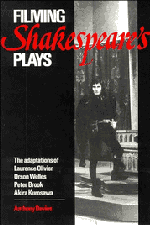 Filming Shakespeare's Plays
Filming Shakespeare's Plays Published online by Cambridge University Press: 01 June 2011
Hamlet poses for the film maker a problem very different from – and much more difficult than – the histories of Henry V and Richard III. The structures of history – even the dramatic structuring of history – can be articulated to varying degrees through the relationship of men to things, of ideas to the concrete world and of motives to actions, without conscious distortion. But of all the plays of Shakespeare, Hamlet is least of all a play which readily enlists spatial detail and the world of objects for its major thematic developments.
There is a castle, there are swords, there is a crown and there is poison. But much of the thematic centre of Hamlet is removed from the means of life and death into the area of their respective values and significance. With the abstract kernel of the play so concentrated in the symbolic value of the objects recounted, the film director has very little spatial material to work with. Robert Duffy, who has written a perceptive and intelligently favourable account of the film in placing it against other Hamlet films, notes the claustrophobic nature of the play and the lack of spatial variety which the action of the play affords as a major adaptive problem for film:
Hamlet is a play which admits no easy translation into film. Much discussed ‘epic’ qualities, particularly the emphatic and rapid shifting of locale and time frame – so often cited as one of the most ‘cinematic’ of Shakespeare's techniques – simply do not operate to any great extent in the play. […]
To save this book to your Kindle, first ensure no-reply@cambridge.org is added to your Approved Personal Document E-mail List under your Personal Document Settings on the Manage Your Content and Devices page of your Amazon account. Then enter the ‘name’ part of your Kindle email address below. Find out more about saving to your Kindle.
Note you can select to save to either the @free.kindle.com or @kindle.com variations. ‘@free.kindle.com’ emails are free but can only be saved to your device when it is connected to wi-fi. ‘@kindle.com’ emails can be delivered even when you are not connected to wi-fi, but note that service fees apply.
Find out more about the Kindle Personal Document Service.
To save content items to your account, please confirm that you agree to abide by our usage policies. If this is the first time you use this feature, you will be asked to authorise Cambridge Core to connect with your account. Find out more about saving content to Dropbox.
To save content items to your account, please confirm that you agree to abide by our usage policies. If this is the first time you use this feature, you will be asked to authorise Cambridge Core to connect with your account. Find out more about saving content to Google Drive.